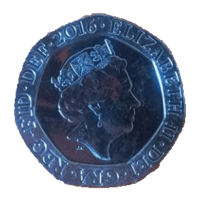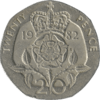Twenty pence (British coin)
| United Kingdom | |
| Value | 0.20 pound sterling |
|---|---|
| Mass | 5.0 g |
| Diameter | 21.4 mm |
| Thickness | 1.7 mm |
| Edge | Plain |
| Composition | Cupro-nickel (1982–present) |
| Years of minting | 1982–present |
| Obverse | |
 | |
| Design | Queen Elizabeth II |
| Designer | Jody Clark |
| Design date | 2015 |
| Reverse | |
 | |
| Design | Segment of the Royal Shield |
| Designer | Matthew Dent |
| Design date | 2008 |
The British decimal twenty pence (20p) coin – often pronounced twenty pee – is a unit of currency equaling twenty one-hundredths of a pound sterling. Like the 50p coin it is an equilateral curve heptagon.[1] Its obverse has featured the profile of Queen Elizabeth II since the coin’s introduction in 1982.[1] Four different portraits of the Queen have been used, with the latest design by Jody Clark being introduced in 2015. The second and current reverse, featuring a segment of the Royal Shield, was introduced in 2008.[1]
Twenty and fifty pence coins are legal tender only up to the sum of £10; this means that it is permissible to refuse payment of sums greater than this amount in 20p coins in order to settle a debt.[2]
As of March 2014 there were an estimated 2,765 million 20p coins in circulation with an estimated face value of £553.025 million.[3]
Design

The original reverse of the coin, designed by William Gardner, and used from 1982 to 2008, is a crowned Tudor rose, with the numeral "20" below the rose, and TWENTY PENCE above the rose.
To date, three different obverses have been used. For coins minted before 2008, the inscription is ELIZABETH II D.G.REG.F.D.. [4] Coins minted after 2008 have the year of minting on the obverse.
As with all new decimal currency, until 1984 the portrait of Queen Elizabeth II by Arnold Machin appeared on the obverse,[5] in which the Queen wears the 'Girls of Great Britain and Ireland' Tiara.
Between 1985 and 1997 the portrait by Raphael Maklouf was used,[5] in which the Queen wears the George IV State Diadem.
From 1998 to 2015 the portrait by Ian Rank-Broadley was used,[5] again featuring the tiara, with a signature-mark IRB below the portrait.
As of June 2015, coins bearing the portrait by Jody Clark have been seen in circulation.
In August 2005 the Royal Mint launched a competition to find new reverse designs for all circulating coins apart from the £2 coin.[6] The winner, announced in April 2008, was Matthew Dent, whose designs were gradually introduced into the circulating British coinage from mid-2008.[7] The designs for the 1p, 2p, 5p, 10p, 20p and 50p coins depict sections of the Royal Shield that form the whole shield when placed together. The shield in its entirety is featured on the £1 coin. The 20p coin depicts the meeting point of the second and fourth quarter of the shield, showing the Lion Rampant of Scotland and the Lions Passants of England. The date no longer appears on the reverse of the coin, and has instead been added to the obverse, where the lettering has been adjusted so as to fit the date in.
Dateless coin
An unusual accidental dateless version of the 20 pence was reported to be in circulation in June 2009, the first undated British coin to enter circulation in more than 300 years. This was the result of the production of a mule, i.e. a version of the coin with a non-standard combination of obverse and reverse face designs. The fault occurred as a result of the 2008 redesign of UK coinage, which moved the date on a 20 pence from the reverse to the obverse (Queen's head side), and a batch of coins were produced using the tooling for the obverse of the old design and the reverse of the new design. The Royal Mint estimated that between 50,000 and 200,000 entered circulation before the error was noticed. The Royal Mint stated these coins were still legal tender, although due to their rarity they are traded above face value by collectors. Following publicity about the coins they were initially traded on eBay for several thousand pounds, although an eBay spokesman was unable to confirm if an accepted winning bid of £7,100 for one coin had actually been transacted.[8][9] In June 2011 they trade at around £100.[10]
Mintages
Machin portrait
- 1982 ~ 740,815,000
- 1983 ~ 158,463,000
- 1984 ~ 65,350,965
Maklouf portrait
- 1985 ~ 74,273,699
- 1986 ~ none
- 1987 ~ 137,450,000
- 1988 ~ 38,038,344
- 1989 ~ 132,013,890
- 1990 ~ 88,097,500
- 1991 ~ 35,901,250
- 1992 ~ 31,205,000
- 1993 ~ 123,123,750
- 1994 ~ 67,131,250
- 1995 ~ 102,005,000
- 1996 ~ 83,163,750
- 1997 ~ 89,518,750
Rank-Broadley portrait
- 1998 ~ 76,965,000
- 1999 ~ 73,478,750
- 2000 ~ 136,428,750
- 2001 ~ 148,122,500
- 2002 ~ 93,360,999
- 2003 ~ 153,383,750
- 2004 ~ 120,212,500
- 2005 ~ 124,488,750
- 2006 ~ 114,800,000
- 2007 ~ 117,075,000
- 2008 ~ 11,900,000
Matthew Dent design
- 2008 ~ 115,022,000 (the dateless coin is included in this mintage)
- 2009 ~ 121,625,300
- 2010 ~ 91,700,500[11]
- 2011 ~ 191,625,000
- 2012 ~ 69,650,030
- 2013 ~ 66,325,000
- 2014 ~ 173,775,000
- 2015 ~ 63,175,000(4th Portrait)
- 2015 ~ 131,250,000 (5th Portrait)
References
- 1 2 3 "Twenty Pence Coin". The Royal Mint Limited. 2015. Retrieved 3 February 2015.
- ↑ Royal Mint Frequently Asked Questions
- ↑ "Mintage Figures". Royal Mint. Retrieved 28 December 2015.
- ↑ Clayton, Tony. "Decimal Coins of the UK – Bronze". Retrieved 2006-05-24.
- 1 2 3 "1p Coin". British Royal Mint. Archived from the original on 2006-04-27. Retrieved 2006-05-23.
- ↑ "Royal Mint seeks new coin designs", BBC News, 17 August 2005
- ↑ "Royal Mint unveils new UK coins", 2 April 2008
- ↑ Grant, Caroline (1 July 2009). "Rare 20p coin on sale for £20,000 on eBay". Daily Mail. Retrieved 8 July 2009.
- ↑ Wentworth, Jo (1 July 2009). "eBay frenzy as undated 20p sells for £8k". Totally Money. Retrieved 8 July 2009.
- ↑ "London Mint Office". Retrieved October 21, 2011.
- ↑ United Kingdom decimal coins issued into general circulation, Royal Mint